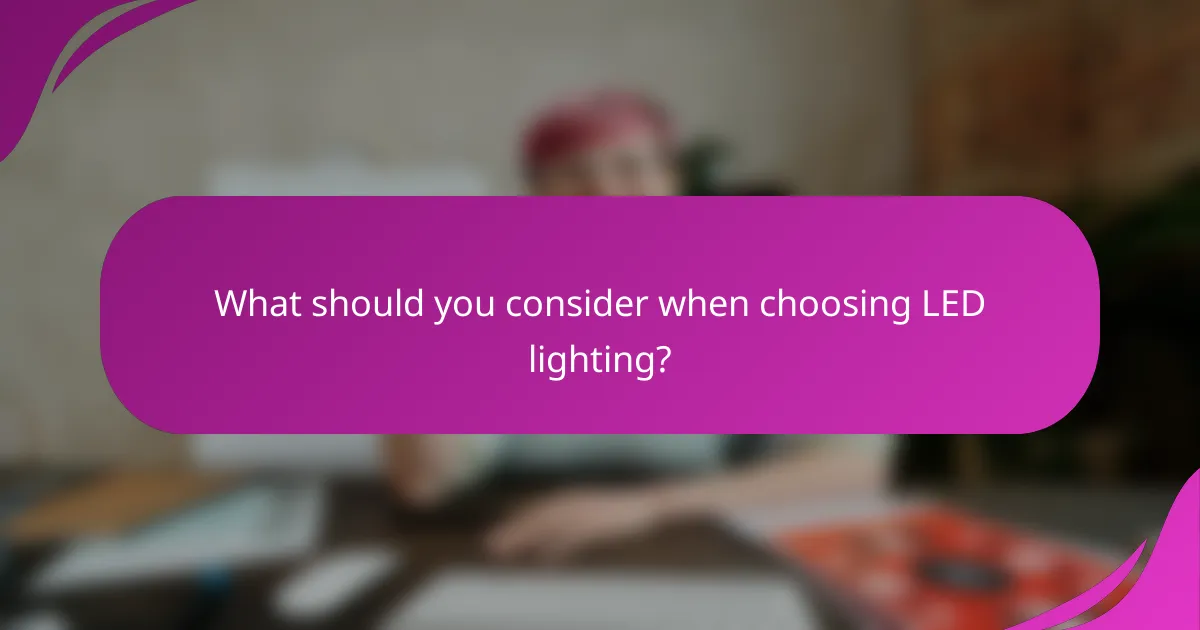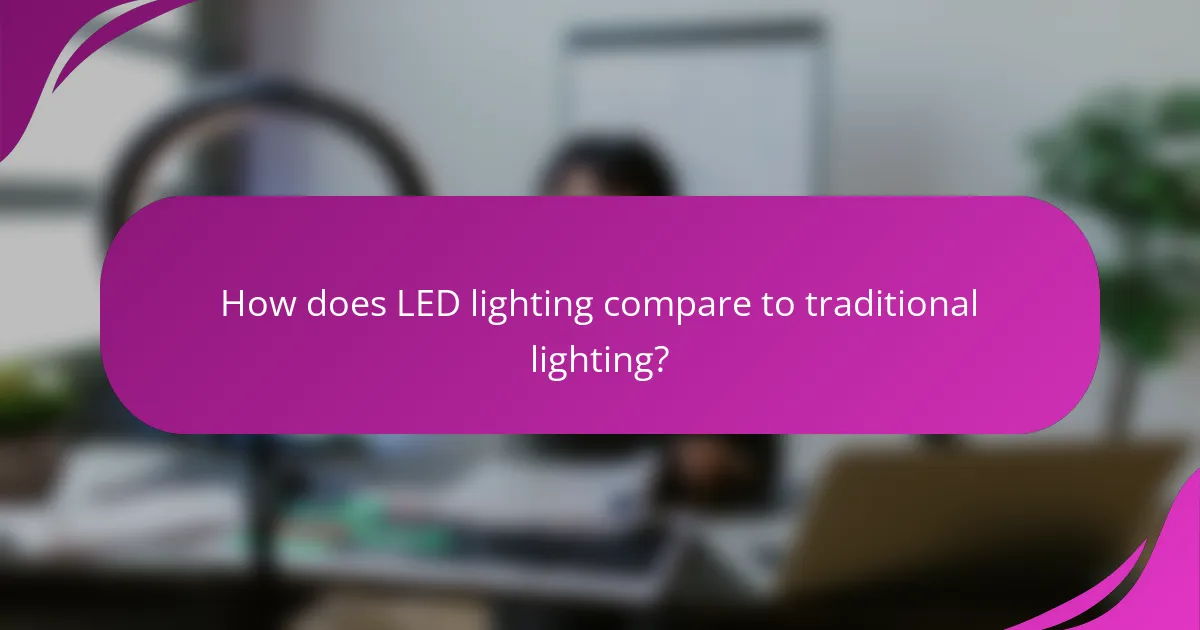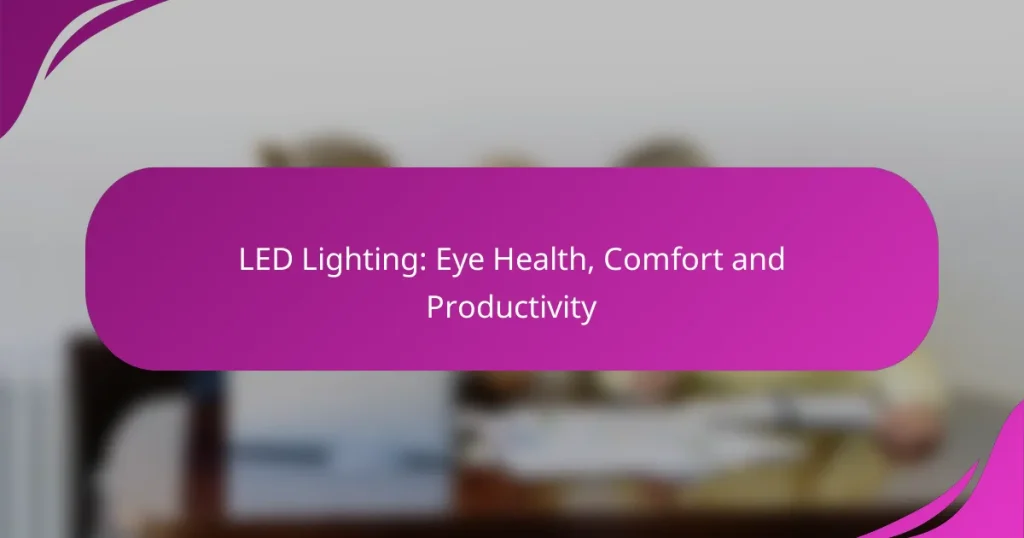LED lighting plays a crucial role in promoting eye health, comfort, and productivity in various settings. By reducing discomfort and strain, LEDs enhance visual clarity and create optimal lighting conditions that improve focus and reduce fatigue. Customizable brightness and color temperature further allow individuals to tailor their environment, fostering better work performance and overall well-being.

How does LED lighting impact eye health?
LED lighting can significantly affect eye health by reducing discomfort and strain during prolonged use. The quality of light emitted by LEDs can enhance visual clarity and comfort, making them a popular choice for various environments.
Reduced eye strain
LED lights can help reduce eye strain, especially in settings where people work for extended periods. Unlike traditional fluorescent lights, LEDs provide a more stable light output, which can minimize flicker and glare that often contribute to discomfort.
To further decrease eye strain, consider using LED lights with adjustable brightness levels. This allows users to tailor the lighting to their specific needs, particularly in environments with varying natural light conditions.
Improved visual comfort
Visual comfort is enhanced with LED lighting due to its ability to produce a spectrum of light that closely resembles natural daylight. This can lead to improved focus and productivity, especially in workspaces where clarity is essential.
Choosing LEDs with a color temperature between 3000K and 4000K is often recommended for optimal visual comfort. This range provides a warm to neutral light that is easy on the eyes and supports better concentration.
Minimized blue light exposure
LEDs can emit blue light, which has been linked to potential eye discomfort and sleep disruption. However, many modern LED products are designed to minimize blue light exposure, making them safer for prolonged use.
To reduce blue light exposure, look for LED lights labeled as “warm white” or those specifically designed to filter out blue wavelengths. Additionally, using blue light blocking glasses in conjunction with LED lighting can offer extra protection, especially during evening hours.

What are the benefits of LED lighting for productivity?
LED lighting significantly enhances productivity by providing optimal brightness and color temperature, which can improve focus and reduce fatigue. The right lighting conditions can lead to better work performance and overall well-being in various environments.
Enhanced focus and concentration
LED lighting can improve focus and concentration by mimicking natural daylight, which helps regulate circadian rhythms. Bright, cool white light can stimulate alertness, making it easier to maintain attention on tasks for extended periods.
To maximize focus, consider using LED lights with a color temperature between 4000K and 5000K during work hours. This range closely resembles daylight and can create an environment conducive to concentration.
Increased energy levels
Proper LED lighting can boost energy levels by reducing eye strain and fatigue. Unlike traditional lighting, LEDs do not flicker as much, which can help maintain consistent energy throughout the day.
For optimal energy, position LED lights to minimize shadows and glare in your workspace. Utilizing task lighting in addition to ambient lighting can enhance visibility and keep energy levels high.
Better mood and morale
LED lighting positively affects mood and morale by creating a pleasant and inviting atmosphere. Warm white LED lights can evoke feelings of comfort and relaxation, while cooler tones can energize and motivate.
To improve workplace morale, consider incorporating adjustable LED lighting systems that allow employees to customize their lighting preferences. This flexibility can lead to higher satisfaction and productivity levels.

How can LED lighting improve comfort in workspaces?
LED lighting enhances comfort in workspaces by providing customizable lighting solutions that cater to individual needs. By adjusting brightness and color temperature, employees can create an environment that minimizes eye strain and boosts productivity.
Adjustable brightness levels
Adjustable brightness levels allow users to set the light intensity according to their specific tasks and preferences. For instance, higher brightness may be beneficial for detailed work, while lower levels can create a more relaxed atmosphere during breaks. Many LED fixtures now come with dimming capabilities, enabling smooth transitions between different lighting scenarios.
When selecting LED lights, look for options that offer a range of brightness settings, typically from around 100 to 1,000 lumens. This flexibility can help reduce glare and enhance visual comfort throughout the day.
Color temperature options
Color temperature options in LED lighting can significantly affect mood and focus. Warmer tones (around 2700K to 3000K) create a cozy environment, ideal for relaxation, while cooler tones (4000K to 6500K) promote alertness and concentration, making them suitable for work tasks. Choosing the right color temperature can help align lighting with the natural circadian rhythm, improving overall comfort.
Consider using tunable white LEDs that allow users to adjust the color temperature throughout the day, mimicking natural daylight patterns. This adaptability can lead to better energy levels and productivity.
Reduced flicker effects
Reduced flicker effects in LED lighting contribute to visual comfort by minimizing eye strain and fatigue. Flicker can be particularly problematic in traditional fluorescent lights, leading to discomfort and decreased productivity. High-quality LED lights are designed to operate with minimal flicker, often below 5%, which enhances visual stability.
When selecting LED fixtures, look for products that specify low flicker rates or are labeled as flicker-free. This feature is especially important for environments where employees spend long hours under artificial lighting, such as offices and studios.

What should you consider when choosing LED lighting?
When selecting LED lighting, consider factors such as light quality, energy efficiency, and compatibility with your existing fixtures. These elements significantly impact eye health, comfort, and productivity in various environments.
Light quality and spectrum
Light quality refers to the characteristics of the light emitted by LEDs, including color temperature and color rendering index (CRI). A higher CRI, ideally above 80, ensures that colors appear more vibrant and true to life, which can enhance visual comfort and reduce eye strain.
The spectrum of light is also crucial; warmer light (around 2700K to 3000K) is often more comfortable for residential settings, while cooler light (4000K to 5000K) may be better suited for workspaces to promote alertness and productivity. Consider your specific needs when choosing the spectrum.
Energy efficiency ratings
Energy efficiency ratings indicate how effectively an LED light converts electricity into visible light. Look for products with the ENERGY STAR label, which signifies compliance with strict efficiency standards. This can lead to significant savings on electricity bills over time.
Typical LED bulbs consume about 75% less energy than traditional incandescent bulbs, making them a cost-effective choice. When comparing options, check the lumens per watt (lm/W) rating; higher values indicate better efficiency.
Compatibility with existing fixtures
Before purchasing LED lighting, ensure that the bulbs or fixtures are compatible with your current lighting setup. Some LEDs may not work with dimmer switches or specific types of fixtures, which can lead to flickering or reduced performance.
Check the specifications of both the LED product and your existing fixtures. If you are retrofitting, consider using LED bulbs designed to fit standard sockets or consult with a professional to avoid compatibility issues.

How does LED lighting compare to traditional lighting?
LED lighting offers significant advantages over traditional lighting, including enhanced energy efficiency, longer lifespan, and reduced heat output. These benefits contribute to better eye health, comfort, and productivity in various environments.
Longer lifespan
LED lights typically last much longer than traditional incandescent or fluorescent bulbs, often exceeding 15,000 to 50,000 hours of use. This longevity means fewer replacements, reducing waste and maintenance costs over time.
For example, while an incandescent bulb may last about 1,000 hours, an LED can last up to 50 times longer. This extended lifespan makes LEDs a more sustainable choice for both residential and commercial applications.
Lower energy consumption
LED lighting consumes significantly less energy compared to traditional lighting options. Typically, LEDs use about 75% less energy than incandescent bulbs and around 50% less than fluorescent lights.
This energy efficiency translates to lower electricity bills, making LEDs a cost-effective solution in the long run. For instance, replacing a 60-watt incandescent bulb with a 10-watt LED can lead to substantial savings over time, especially in high-use areas.
Less heat emission
LED lights emit very little heat compared to traditional lighting, which can waste energy and contribute to higher cooling costs. Most of the energy consumed by LEDs is converted into light rather than heat.
This lower heat output not only enhances comfort in indoor spaces but also reduces the risk of heat-related issues, such as burns or fire hazards. In environments like offices or homes, this can lead to a more pleasant atmosphere and improved safety.

What are the local regulations for LED lighting in the UK?
In the UK, regulations for LED lighting focus on energy efficiency and safety standards. Compliance with these regulations ensures that LED products are safe for consumers and contribute to energy conservation efforts.
Energy efficiency standards
The UK adheres to the European Union’s Ecodesign Directive, which sets energy efficiency standards for lighting products, including LEDs. These standards require that LED lights achieve a minimum efficiency level, typically around 85 lumens per watt, to qualify for sale.
Additionally, the Energy Labelling Regulation mandates that LED products display energy labels indicating their efficiency class. Consumers can easily compare energy consumption, helping them make informed choices.
Building codes compliance
Building codes in the UK require that all installed lighting, including LEDs, meet specific safety and performance criteria. This includes compliance with the IET Wiring Regulations (BS 7671), which govern electrical installations and ensure safe operation.
When retrofitting or installing new LED lighting, it’s essential to consult local building regulations, as they may vary by region. Ensuring compliance can prevent costly fines and ensure the safety of occupants.


